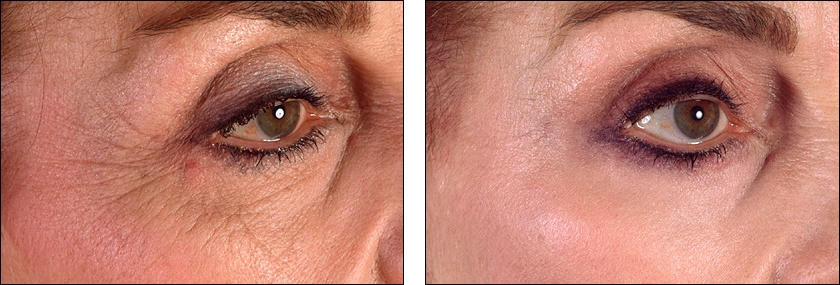|
 |
The peel is perfect for the fine lines that develop in the lower eyelids,
spilling out over the cheekbones and in to the crows feet regions. She
didn't have any fat bulges in her lower lids, making the peel the correct
operation.
In men, I don't like to peel an isolated area, such as just the lower eyelids. The peel usually changes the skin color a small amount, and men, who
don't wear makeup, at least this year, might have a harder time hiding a small (or rarely
large) pigment change in the peeled skin.
For that reason, I often ask my male peel candidates to wait until we feel
that a peel of the entire face makes sense.
|

 Go here to learn how to send your photos to Dr. Denenberg, Go here to learn how to send your photos to Dr. Denenberg,
 or to arrange a personal consultation. or to arrange a personal consultation.

Next: an example of the solid advice Dr. Denenberg gives patients on RealSelf.com.
Get that advice for your own situation by emailing your photos to Dr. Denenberg.
|
Questioner:
I'm trying to understand my surgeon's operative report in order to understand what was and wasn't done. Please help?
As the photos demonstrate, my primary rhinoplasty was not successful in any way, shape, or form. Since acquiring my surgeon's operative report, I've been trying to make sense of the medical terminology in order to understand what was done to my nose during my operation... Thus educating myself. I want to fully understand as I navigate my revision consults. I keep telling people that the "tip wasn't touched at all," but aside from that, could someone please help me interpret the report? (Photos).
(Questioner submitted photos)
Dr. Denenberg's answer: It doesn't look as though much was done to your tip.
The report says "a portion of the lower lateral cartilages" was removed. That *can* result in a tip that is less wide, or less projecting, but it's the rare, rare tip that will respond completely to a simple removal of some of the tip cartilages as described. Perhaps your tip requires much more advanced work to change it's size and shape.
If you are seeking a revision, be very careful. Revision rhinoplasty is far, far more difficult than a first-time rhinoplasty, and even in a first-time rhinoplasty, most plastic surgeons are not expert enough to handle more difficult tip structures. You must see before and after photos of a doctor's work before deciding whether to use him for your revision. See the attached video and the Web reference link for examples of the changes that are possible in expert hands.
Link to this question on RealSelf.com
|


| 

